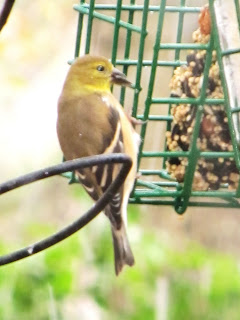Pine Warblers have been among the winter visitors to my backyard feeders. Many thanks to Tammy Sanders of Charlotte who gently corrected my earlier misidentification of this bird as an American Goldfinch. Two Chipping Sparrows are in the background.

The Pine Warbler is a new bird to me. According to some reference material, it is in South Carolina year-round but I can't recall seeing it in my backyard until this winter.

The White-breasted Nuthatch is another new discovery this winter in my backyard. This bird really likes to go upside-down!
The smaller Downy Woodpecker has been a mainstay this winter. I like the claw detail captured in this photo.
The cute Tufted Titmouse is one of the most common birds I see. But common doesn't mean that I take them for granted!

The Titmouse and Carolina Chickadee often hang out between feeds in holly shrubs next to my backyard patio.

The Chipping Sparrow is a winter visitor to coastal South Carolina. Its found more inland in the Southeast and Deep South.
 The Carolina Chickadee is a chirpy active bird and a common site around my house.
The Carolina Chickadee is a chirpy active bird and a common site around my house.


The Black-capped version has narrow white edges on on its wing feathers that the Carolina doesn't have.

I'll be interested to see who else shows up this winter. The food and water will be out for all comers.
Pretty cool having some snow today. The birds seemed to like it too!

The Pine Warbler is a new bird to me. According to some reference material, it is in South Carolina year-round but I can't recall seeing it in my backyard until this winter.

The White-breasted Nuthatch is another new discovery this winter in my backyard. This bird really likes to go upside-down!
I hadn't seen this bird before. At first, I thought it was the Carolina Chickadee. But the Nuthatch is much larger and is striking and stylish in its black and grey coloring.
The Nuthatch just about drove me nuts trying to photograph. They are quite flitty, never staying put but for a few seconds. But I got a few decent photos.
A third newcomer to my yard also took some bird book and online investigation. Meet the Dark-eyed Junco. This snowbird, also called the Northern Junco, spends the rest of the year up North, as far away as Canada.
The Junco's white/pink beak caught my attention first, then its clearly separated dark top half of its body and its white bottom half. This bird likes to graze for food on the ground, and didn't fly up to my feeders.
The Junco's white/pink beak caught my attention first, then its clearly separated dark top half of its body and its white bottom half. This bird likes to graze for food on the ground, and didn't fly up to my feeders.
Northern Mockingbirds are common in my area but not in my backyard. But recently they've been regulars at my feeders. I've never really seen this bird up close. Doing so reveals its cool eye pattern, the dark straight line through its eye reminds me of war paint. This probably works for the aggressive, fiesty Mockingbird when it attacks larger birds, as it's known to do.
At my feeders, the Mockingbird is a perfect "gentleman." It shows no aggression toward the other bird breeds. Maybe because they are usually much smaller?
Red-bellied Woodpeckers are year-round in my area. These colorful birds are not above swooping down to my feeders at least a few times a day.The smaller Downy Woodpecker has been a mainstay this winter. I like the claw detail captured in this photo.
The cute Tufted Titmouse is one of the most common birds I see. But common doesn't mean that I take them for granted!

The Titmouse and Carolina Chickadee often hang out between feeds in holly shrubs next to my backyard patio.

The Carolina Wren is South Carolina's state bird. Back in June, I did a posting about a crowded Carolina Wren nest in a bird house hanging from my front porch: http://mybirdseyeviews.blogspot.com/2010/06/carolina-wren-nest.html
Thanks again to Tammy Sanders for identifying the above bird as a Chipping Sparrow. It's similar somewhat to the Carolina Wren but the black line through its eye is a clear distinction, among others. The Chipping Sparrow is a winter visitor to coastal South Carolina. Its found more inland in the Southeast and Deep South.


You may be more familiar with the Black-capped Chickadee. I know I was and thought that's what I was seeing. Only later did a discover that our region has its own Carolina Chickadee.

The Black-capped version has narrow white edges on on its wing feathers that the Carolina doesn't have.

I'll be interested to see who else shows up this winter. The food and water will be out for all comers.
ADDED DECEMBER 26, 2010
A rare snow in the Charleston area this afternoon. Bird activity as busy as ever, if not more frenetic.
A Pine Warbler feeds away amid the snow flurry. A rare snow in the Charleston area this afternoon. Bird activity as busy as ever, if not more frenetic.
Pretty cool having some snow today. The birds seemed to like it too!
















No comments:
Post a Comment